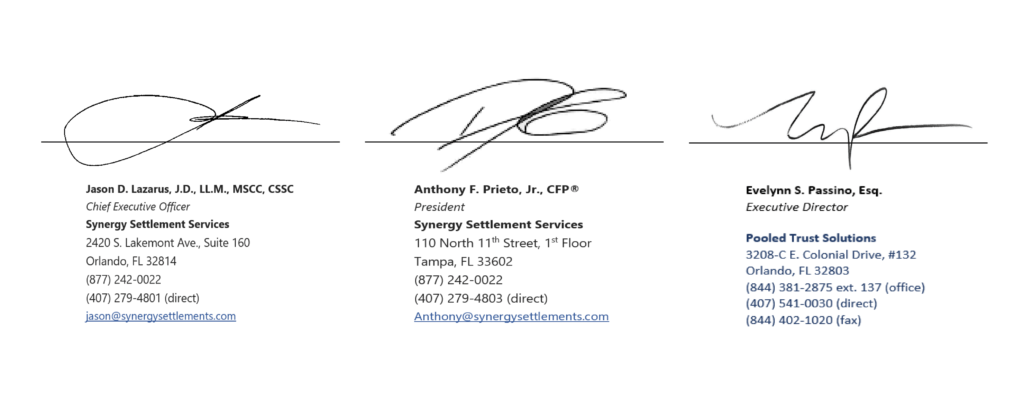ANNOUNCEMENTS
Latest announcements, industry news and InSight’s from Synergy Settlement Services.
Jason D. Lazarus, J.D., LL.M., CSSC, MSCC
June 9, 2022
On June 6th, 2022, the United States Supreme Court decided in a 7-2 decision to allow Florida Medicaid, pursuant to Section 409.910 of the Florida Statutes, to recover its lien from all medical damages past and future. This decision has nothing to do with future eligibility for Medicaid post settlement, that is still protected by special needs trusts, instead, it allows a state Medicaid agency to pursue its lien against all medical damages in the case. This is a departure from the dictates of Ahlborn which protected a Medicaid recipients’ property right in their settlement as dictated by the federal anti-lien provisions.
Gallardo argued that the anti-lien provisions in the Medicaid Act prohibited Florida Medicaid from attempting to recover its lien from anything other than the amounts properly allocable to past medical expenses. The Supreme Court held otherwise finding that it falls within an exception to the anti-lien provisions that served as the pillars of the Ahlborn decision. Further, the court held that the assignment provisions in the Medicaid Act requires a Medicaid beneficiary, as a condition of eligibility, to assign all rights to payments for medical care from a third party back to the state Medicaid agency. And states must enact recovery provisions that allow for the state to recover from liability third parties when a Medicaid beneficiary is injured, and Medicaid pays for that care. While the court upheld the property right and anti-lien prohibitions against recovery from non-medical damages, it held it didn’t protect damages that were for medical care.
The bottom line of the holding is as follows:
“Under §1396k(a)(1)(A), Florida may seek reimbursement from settlement amounts representing “payment for medical care,” past or future. Thus, because Florida’s assignment statute “is expressly authorized by the terms of . . . [§]1396k(a),” it falls squarely within the “exception to the anti-lien provision” that this Court has recognized. Ahlborn, 547 U. S., at 284.”
Justice Sotomayor’s dissent in Gallardo is right on point about the inequity of the majority’s opinion related to Medicaid liens and from what elements of damages a state agency can recover from: “It holds that States may reimburse themselves for medical care furnished on behalf of a beneficiary not only from the portions of the beneficiary’s settlement representing compensation for Medicaid-furnished care, but also from settlement funds that compensate the Medicaid beneficiary for future medical care for which Medicaid has not paid and might never pay. The Court does so by reading one statutory provision in isolation while giving short shrift to the statutory context, the relationships between the provisions at issue, and the framework set forth in precedent. The Court’s holding is inconsistent with the structure of the Medicaid program and will cause needless unfairness and disruption.” Justice Sotomayor also recognized that due to the majority’s ruling, many injury victims would have less dollars from their settlement to place into federally-authorized special needs trusts that protect their ability to pay for important expenses Medicaid will not cover. This is exactly what had been done for the benefit of Gallardo when her case was settled but now she will have less go into that trust since more money will have to go to reimburse Florida Medicaid.
So, what does Gallardo mean for injury victims? A state Medicaid agency or its recovery contractor can now take the position that the recovery right applies to past and future medicals so when you do an Ahlborn analysis, it would be the appropriate reduction percentage (using a pro-rata formula) applied to the entire value of medical damages to see if there is a reduction in the lien. Pre-Gallardo, some states were already taking that position as well as some recovery contractors. From a practical perspective, in cases with a large life care plan or a lot of future medicals, there may not be a reduction at all in the lien. It is going to be important that the non-economic damages get properly valued with some multiplier times specials to make strong arguments for a reduction.
In the end, Medicaid beneficiaries will not net out as much from their settlements as they should. Some cases may not be brought, and more injury victims will wind up quickly back on Medicaid post recovery. It is an unfortunate end result and just bad law.
To read the full opinion, click HERE
This decision doesn’t mean though all is lost, but you need experts to help you navigate through the lien resolution minefield. Contact Synergy to help find your way to the best outcome for your client.
To read a whitepaper for a summary of the law pre-Gallardo, click HERE.

May 5, 2022
The following communication is in response to press release 2022-76 published by the Securities and Exchange Commission on May 2nd, 2022. Synergy Settlement Services, Inc. (SSS), its principals and the Foundation for Those with Special Needs (“Foundation”) are disappointed that the Securities and Exchange Commission has opted to file a lawsuit as outlined in the press release.
We strongly believe this Government action is unwarranted under the law and facts, we adamantly deny that any trust beneficiary or retained funds were improperly used and intend to vigorously defend this case in Court.
The SEC’s press release used salacious terms like “beach parties” and “golf tournaments” to describe events held by outside non-profits but seemingly insinuated that the events were thrown by Synergy. While those terms may help generate media headlines, it’s just not accurate. As an example, the alleged “beach parties” thrown by Synergy is actually referencing a contribution by The Foundation to a state “Civil Justice Foundation” that is a 501(c)(3). The mission of this organization, like others The Foundation has supported over the years, is to keep the civil justice system accessible.
Since its inception, The Foundation has donated hundreds of thousands of dollars to a variety of non-profit organizations doing incredible charitable work across the country.
Rest assured that as we work through the process of exonerating ourselves, we remain 100% committed to serving our clients and the families you fight for. This will not impact our operations or results. We remain steadfast in our dedication to the work of improving the lives of injury victims.

December 6, 2021
In HMS Holdings LLC v Ted A Greve & Associates P.A. et al, 2021 WL 5163308, an ERISA self-funded health plan was denied a temporary restraining order (TRO) on settlement funds. The court found that the health plan did not present sufficient evidence to satisfy all necessary requirements to issue a TRO, including that the TRO was required to prevent irreparable harm. This was mostly due to the fact that the health plan delayed in bringing the action and that nine-month delay in bringing suit supported the conclusion that irreparable harm will not be suffered in lieu of a temporary restraining order.
The injured party was in an automobile accident and the ERISA health plan paid over $100,000 in medical benefits. The settlement was limited to $100,000. The injured party notified the health plan of their pursuit of a claim against the tortfeasor and asked the plan to prove its self-funded status as otherwise the plan would not have a right to a recovery under North Carolina law.
The ERISA plan filed the ERISA action asking for the TRO and preliminary injunction to restrain the injured party from “wasting, disbursing, spending, converting or comingling” the settlement funds. The ERISA plan expressed concern that if the injured party dissipated settlement funds on non-traceable items, then the health plan would be deprived on its right of recovery. The ERISA plan cited the US Supreme Court’s Montanile case as its support. Montanile v. Bd. of Trustees of Nat’l Elevator Indus. Health Benefit Plan, 136 S.Ct. 651 (2016).
The court noted that when evaluating a request for a TRO, the plaintiff must demonstrate that: (1) it is likely to succeed on the merits; (2) it will likely suffer irreparable harm absent an injunction; (3) the balance of hardships weighs in its favor; and (4) the injunction is in the public interest. The ERISA plan argued that it would suffer irreparable harm because under Montanile, it can only obtain equitable relief against identifiable proceeds. The ERISA plan argued that if the court did not issue an order preventing the firm / injured party from transferring or comingling funds then their pursuit of a recovery would be out of the reach of an ERISA action.
The court stated that irreparable harm was not apparent because the ERISA plan’s injury could be remedied in the ordinary course of litigation. This was especially the case because the health plan had pled multiple alternative causes of action in its Complaint that did not rely on ERISA and those theories of liability did not appear to be limited to equitable relief.
The court also stated that the ERISA plan’s delay in bringing a lawsuit and/or the TRO may indicate the absence of irreparable harm. Although the ERISA plan claimed that it was doing what the Supreme Court required them to do, they were not immediately suing to enforce its lien as the Court required. The court noted that more than 9 months had passed from when the injured party notified the ERISA plan of the settlement. A long delay in pursuing their claim indicated that speedy action, in the form of a TRO, was not required to protect the health plan’s rights.
Interestingly, the court said that it is hesitant to issue a decision that could be interpreted to require such parties to delay distribution of personal injury lawsuit proceeds for months on end to preserve the viability of potential subrogation/reimbursement claims under ERISA, thereby appearing to have sympathy for the injured party and a delayed disbursement of settlement proceeds. Shortly thereafter, the court expressed sympathy for the health plan because if there is a wrongful double recovery to the injured person then it would be a miscarriage of justice. The court acknowledged that the health plan is in a difficult position with ERISA requiring the request of equitable relief by filing suit immediately or risking loss of the ERISA claim. In the end, the ERISA plan did not obtain the TRO and will be forced to decide whether it pursues its claim in another manner.
Rasa Fumagalli JD, MSCC, CMSP-F
In Penelope Stillwell v State Farm Fire and Casualty Co., et al. case (2021 WL 4427081), a plaintiff attempts to impose primary payer status on a liability insurer post-settlement via a qui tam action in federal district court. The U.S. District Court, Middle District of Florida, Tampa Division addressed in this recent decision Stillwell’s complaint under the False Claims Act (FCA) and the MSP Act, the basis of the qui tam action. The essence of the claim against the insurer, State Farm, was that “by failing either to settle for an amount exceeding the expected medical expenses or to provide in the settlement some other mechanism to pay future medical expenses, the insurers failed to discharge their primary-payer responsibility and remain primary payers for post-settlement medical expenses.” US District Judge Steven D. Merryday dismissed the Stillwell’s complaint with prejudice for a failure to state a claim under the FCA and MSP.
The underlying case involved an Indiana state court negligence action for injuries sustained by William Stillwell, a Medicare beneficiary, during a fall. Although the homeowners’ association, property management and landscaping company insurers reached a settlement agreement with the Stillwells for the lump sum of $200,000, the Stillwells refused to execute the settlement documents since the settlement didn’t include a Medicare Set-Aside to cover William’s expected future medical expenses that were estimated to be $700,000. The Indiana trial court’s determination that the settlement was enforceable, was affirmed by the Indiana Court of Appeals. The terms of the settlement agreement reflected the insurers agreement to pay Medicare’s conditional payments directly from the settlement agreement. After the settlement, CMS demanded reimbursement of $29,509.33 in conditional payments after procurement costs were deducted.
After the losses in the Indiana state courts, the Stillwells sued the insurers under the FCA arguing that the insurers failed to discharge their primary payer responsibility since the settlement was less than the estimated future medical expenses. They also argued that the insurers should remain primary payers for post-settlement medical expenses and that their failure to report this responsibility to the Centers for Medicare & Medicaid Services (CMS) caused William’s physicians to falsely bill Medicare. The defendants argued that the Stillwells became the primary payers for post-settlement care after enforcement of the settlement agreement. Challenges to the pleadings were also raised.
In considering these arguments, the District Court noted the lack of CMS rules for post-settlement futures in liability settlements when compared to the rules for workers’ compensation settlements. The District Court’s opinion went out of its way to explicitly point out that “CMS has decidedly avoided regulating private liability settlements that include a Medicare beneficiary.” It declined to impose any such obligations since establishment of such rules belongs to the legislature or executive branches.
Stillwell also argued that the insurers hid their status as primary payers from CMS since they failed to report the Total Payment Obligation to Claimant (TPOC) settlement under their Section 111 Mandatory Insurer Reporting obligation. The Court found no support for this assertion since CMS had notice of the settlement based on the resolution of the conditional payments. Similarly, Stillwell’s claim that the insurers failed to complete Section 111 reporting of an Ongoing Responsibility for Medical (ORM) post-settlement was unfounded since there is no such reporting obligation for liability insurers for post-settlement medical expenses.
The Court also considered Stillwell’s claim that a settling party must consider Medicare’s interests by selecting one of the following mechanisms: the creation of a Medicare Set-Aside, an apportionment of part of the settlement for future medical expenses, a payment of a portion of the settlement into the Medicare Trust Fund or the proposal of an alternative plan to CMS. In examining these options, the District Court noted that there was no law that required the creation of a Medicare Set-Aside to cover future medical expenses in a liability case. Since a party may use the entire settlement to pay for post-settlement Medicare covered treatment, there was also no obligation to apportion funds from the settlement. Regarding Stillwell’s claim that the settlement should have included an amount that covers expected future medical expenses, the Court noted no substantive duty to include this in a personal injury claim settlement. Under the terms of the settlement agreement, the Stillwells became primarily liable for any future injury-related medical expenses. Since the Stillwells were responsible for post-settlement medical care, the insurers had no ORM to report.
The remaining arguments in the case focused on whether Stillwell’s FCA claims sufficiently alleged causation and a conspiracy between the insurers to violate the FCA and submit false claims or statements to Medicare. The Court found the claims were insufficient and warranted dismissal. Although Stillwell prevailed on her argument that her complaint was not a shotgun pleading, her action was dismissed with prejudice for failing to state a claim.
Take Away
Since William Stillwell died before the second amended complaint under the False Claims Act (FCA) and MSP Act was submitted, his need for any ongoing post-settlement medical care was moot. Rather, it appears that Penelope Stillwell’s FCA may have been motivated by a financial incentive along with a desire to force the Court to provide guidance regarding the consideration of Medicare’s interest in post-settlement injury-related care in a liability settlement.
It is clear that the Stillwells didn’t understand that the settlement of the case would make William the primary payer for any post-settlement injury-related care. Although his estimated future medical treatment would be about $700,000, liability settlements are compromise settlements that involve many more elements of damages than those found in workers’ compensation settlement. In light of this, it would be extremely rare to have a liability settlement include the full value of the estimated future medical care or even include an apportionment in the first place.
A discussion of the MSP Act and its potential impact on a settlement is a proactive way to prevent MSP confusion. Discussing the ramifications of the MSP with injury victims prior to settlement is important to avoid issues such as this and prevent the need to be in a federal district court post-settlement.
Learn more about Synergy’s MSP Compliance Services here.
February 23, 2021
Rasa Fumagalli, JD, MSCC, CMSP-F
The Centers for Medicare & Medicaid Services (CMS) agency has made significant improvements over the years in their online self-service tools for Medicare beneficiaries, their representatives, insurers, and recovery agents. Beneficiaries may obtain detailed information regarding their claims by registering on the MyMedicare.gov website. If the beneficiary has a third-party claim, he or she can access the Medicare Secondary Payer conditional payment information from their MyMedicare page or by entering the Medicare Secondary Payer Recovery Portal (MSPRP). Click here to see the MSPRP User Guide.
Today, the MSPRP allows beneficiaries and their representatives to self-report claims, upload Proof of Representation and Consent to Release forms, obtain conditional payment information and submit disputes to CMS. The MSPRP also allows the beneficiary or his representative to make an electronic payment of the conditional payment demand through Pay.gov, a secure government-wide collection portal. With the current delays that the USPS is experiencing, this is a useful alternative. Additional details regarding the process may be obtained here: https://go.cms.gov/2ZICL2N
February 2, 2021
Synergy handles Hospital Lien disputes nationally on behalf of Trial Lawyers and their injured clients. Synergy’s Michael Walrath, Esq., as the nation’s leading authority on the nuances of state-specific hospital lien law and the facts underlying the “reasonable value” of hospital care, was tapped to assist investigative reporter Jessica Silver-Greenberg in her research for the New York Times expose of hospital lien practices. The article, entitled How Rich Hospitals Profit From Patients in Car Crashes, was published on February 1st, 2021, and can be viewed in its entirety here.
As this explosive report details, hospitals routinely forgo health insurance for auto accident patients, instead using liens to enhance their reimbursement and usurp money otherwise intended to compensate injury victims for lost wages, pain, and suffering, and other non-medical-special damages.
Cited examples include Monica Smith, a Medicaid recipient, whose Medicaid reimbursement would have been $2,500, but Parkview Regional Medical Center in Indiana instead levied a hospital lien for $12,856.00. While not illegal in most states, the practice effectively diverts settlement proceeds from injury victims in need, to overreaching hospitals intent on maximizing profits. A memo surfaced in 2014 litigation in Washington State, which estimated the practice generated an additional $10 million annually, to the facility.
As the article points out, lien practices are so lucrative, many hospital systems use specialized lien and debt collection companies to enhance their receivables. Post-settlement lien disputes are sunk costs on a file, further disincentivizing injury lawyers, who are already at a disadvantage for lack of internal hospital data. Synergy’s Medical Bill Clinic is available to level the playing field by leveraging specialized systems, data sets, and hospital billing experts to ensure your clients do not pay more than the reasonable value of the care they receive. Learn more about Synergy’s Medical Bill Clinic here.
READY TO SCHEDULE A CONSULTATION?
The Synergy Settlements team will work diligently to ensure your case gets the attention it deserves. Contact one of our legal experts and get a professional review of your case today.







